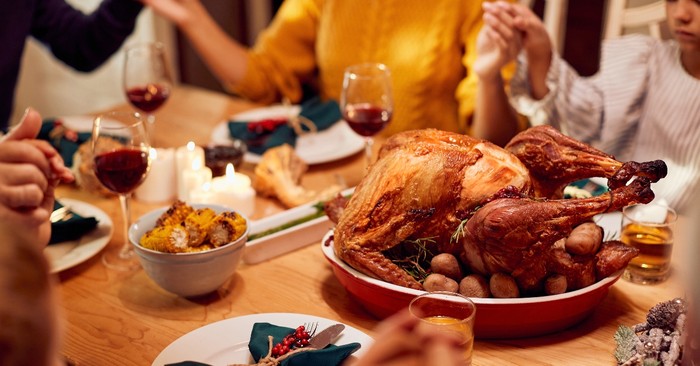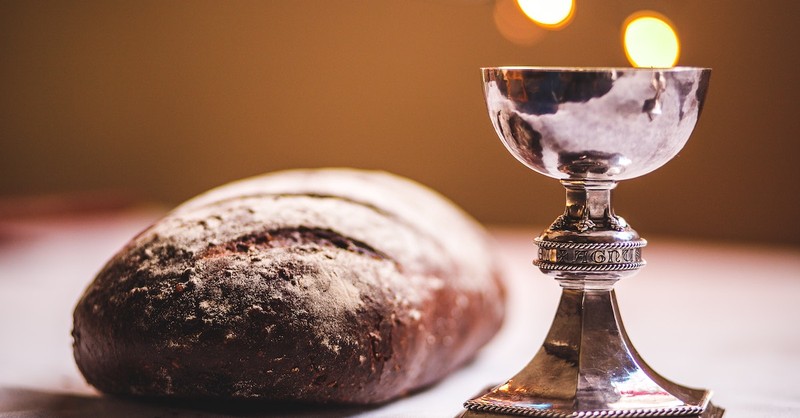
Jesus was a regular guest in other people’s homes. Jesus ate with those who were important (Luke 7:36, 11:37, 14:1), those who were his disciples and followers, (Luke 10:38), and those who were considered outcasts in society (Matthew 9:10, Luke 19:1-5).
When we can think of Jesus being a guest in our homes, a popular quote might come to mind. Perhaps it hangs as a plaque in your dining room. It says “Christ…the unseen guest of every meal, the silent listener to every conversation.” Yet, as seen in the Gospels, Jesus was far from silent during the meals he attended. He used these times to minister, teach, and wisely admonish. At some meals, we learn how people reacted to Jesus. Other times we are left not knowing and wondering how they took his words.
As we look at who Jesus ate with, we can consider how we would respond if Jesus were a guest at our table this Thanksgiving. But first, it is helpful to be aware of some of the cultural details associated with meals in Jesus’ day.
Photo credit: ©Getty Images/Drazen Zigic

What Was Mealtime Like in Jesus’ Day?
Background information can help us understand some of the aspects that seem unusual to us, and the cultural similarities and differences from our own mealtimes today.
Just as today, shared meals were an important part of culture and community life in Jesus' time, probably even more so then without other forms of communication. Invitations would be sent out in advance to guests, especially for bigger occasions. However, rarely did whole families dine with the guests. Instead, only the head of the household would be present at the table.
Instead of sitting at a table, meals would be taken by reclining on couches. The couches were arranged around three sides of a low table. The left elbow rested on cushions while the right hand was free for eating from shared dishes. It was customary for shoes to be removed and feet to be washed. Guests would not have random positions around the table, instead those to the right of the servers were considered the most important and in the places of honor. Those to the left of the servers were in the least important positions.
There would be no specific room for dining, instead meals were given in rooms that had multiple functions, and even in outdoor courtyards. This meant meals were often open to the street and so could be seen by the public and passersby.
Within this context, Jesus ate with three distinct groups of people: sinners, Pharisees, and his disciples.
Related article - What Is the Cultural Significance of Sharing a Meal?
Photo credit: Unsplash/James Coleman

Jesus’ Meals with Sinners
“Sinners,” in the Gospels, is a title given to a category of Jews who did not keep the Mosaic law and traditions as set out by the Pharisees. Therefore, they were considered to be ceremonially unclean. Within this group were also the morally unclean. One other group included with sinners were tax collectors. Responsible for collecting taxes and tolls on behalf of the Roman government, and within a system open to corruption, the tax collectors were often dishonest. They over-taxed their own countrymen, thus lining their own pockets.
It is with these people that Jesus, from the beginning of his ministry, chose to spend his time (Matthew 11:19). Normally, for someone in Jesus’ position as a rabbi, he would have been expected to keep Himself separate from those who were ceremonially and morally unclean. As did the Pharisees who would not have considered sharing a meal with anyone from this group.
Jesus, however, had a specific mission. Jesus’ ministry and time on earth was one of celebration. At the beginning of his ministry, he announced the time of God’s favor to earth — he had come to bring good news (Luke 4:16-21). Eating meals with sinners symbolized God’s message of forgiveness for all people. These people might not have been accepted by the society of their day, but they were welcomed into God’s kingdom.
When Jesus ate with sinners, lives were transformed. Sins were forgiven, faith was commended, peace was bestowed (Luke 7:44-50), lives were saved, and attitudes and behaviors were changed (Luke 19:1-10) These people reacted to Jesus with an outpouring of heart-felt gratitude shown through emotions and actions (Luke 7:38, Luke 19:8).
If Jesus were at our table this Thanksgiving, we too can react with joy and gratitude. When we feel like outcasts, Jesus is willing to commune with us. However unacceptable we feel, Jesus' offer of love and forgiveness is real. Whatever we may have done, Jesus does not condemn but freely offers a fresh, new start.
The meals Jesus shared with sinners stand in contrast to the meals Jesus shared with Pharisees.
Photo credit: ©Getty Images/Yacobchuk

Jesus’ Meals with Pharisees
The Pharisees are not described in a good light in the Gospels. On reading about them, none of us would like to be labeled a Pharisee, or a sinner for that matter.
The Pharisees were a Jewish sect and an influential group recognized as religious leaders. They promoted piety according to the Mosaic law for the lives of ordinary people. Their traditions came with numerous regulations that had to be followed. This led to their own self-importance and self-righteousness, while judging the sinfulness of others. They also appeared to be blind to who Jesus was.
It seems that many of them clashed with Jesus and were critical of his behavior and teaching in relation to their own standards and conduct (Mark 7:1-5). (However, in John 3:1-21, Nicodemus shows that it was not all of them.) But, at the same time they regarded Jesus as their equal (John 3:2). They rebuked Jesus and his disciples for breaking the rules regarding the Sabbath (Matthew 12:12), mixing with sinners (Matthew 11:19), and having the authority to forgive sins (Luke 5:21).
In return, Jesus warned the people of the Pharisees’ hypocrisy — “for they do not practice what they preach” and “they tie up heavy, cumbersome loads and put them on other people’s shoulders, but they themselves are not willing to lift a finger to move them” (Matthew 23:3-4). Yet still, when invited, Jesus went to dine in the homes of Pharisees.
On one hand, the Pharisees treated Jesus like an equal, but on the other hand their invitations gave them an opportunity to question Jesus.
On one occasion, Jesus was invited to have dinner with a Pharisee named Simon (Luke 7:36-50). We learn that Simon did not wash Jesus' feet before dinner, greet Him with a kiss, or anoint Him with oil as was the custom. It would be the equivalent of not meeting our guests at the door, shaking their hands or giving a hug, or taking their coats when they arrived. These small gestures show hospitality and kindness. And Jesus noticed the way he was treated by Simon.
It appears that Simon was watching Jesus carefully and critically (Luke 7:36-50): “If this man were a prophet, he would know who is touching him and what kind of woman she is — that she is a sinner.”
Jesus' rebuke of Simon is spoken in kindness through a parable (Luke 7:41-42): “Two people owed money to a certain moneylender. One owed him five hundred denarii, and the other fifty. Neither of them had the money to pay him back, so he forgave the debts of both. Now which of them will love him more?” As the Pharisee could consider his own love for God, we too can think carefully how much we have been forgiven and examine our own gratitude and love for Jesus.
On another occasion, Jesus gave a stern rebuke to the leaders present at a meal (Luke 11:37-54). Jesus' reaction can seem surprising and shocking, but at the same time, we see God’s heart is for these leaders to practice justice and love (Luke 11:42).
If Jesus were at our table this Thanksgiving, perhaps we would have an opportunity to remember the importance of God’s love and justice, rather than seeing the Christian life as a list of dos and don’ts.
Photo credit: ©Getty Images/Andranik Hakobyan

Jesus’ Meals with His Followers and Disciples
Jesus’ disciples included the twelve men that he specifically called to be apostles, singled out to learn from Him: “Simon (whom he named Peter), his brother Andrew, James, John, Philip, Bartholomew, Matthew, Thomas, James son of Alphaeus, Simon who was called the Zealot, Judas son of James, and Judas Iscariot, who became a traitor” (Matthew 10:2-4).
There were also many other men and women who were committed to Jesus and considered as disciples. They included those who were his companions as he traveled around, and who supported Him financially (Luke 6:13-17, Luke 8:1-3, Luke 10:1). These men and women were with Jesus from the beginning of his ministry until after his death to care for his body (Mark 15:43, Mark 15:46, Mark 16:1).
The most well-known story of Jesus being a guest of one of his followers is the account of Martha opening her home to Jesus and his disciples (Luke 10:38). We sense that on this occasion, Jesus and his disciples, as well as Martha and Mary, are comfortable in each other's company (John 11:5).
There is the ease with which Mary sat at Jesus’ feet and listened to Him (Luke 10:39). Her enthusiasm and passionate desire to learn from Jesus are apparent. She had the freedom to sit as a student, whereas normally a woman would not have been able to learn from Jewish teachers.
Then there is the uninhibited way in which Martha complained to Jesus about the lack of help she got from Mary with the preparations (Luke 10:40). If Mary hung onto every word that Jesus said, then Martha could use the authority of Jesus to tell Mary what she really should be doing, helping Martha with the meal.
And then we have Jesus’ tender response to Martha: “’Martha, Martha,’ the Lord answered, ‘you are worried and upset about many things…’” (Luke 10:41). Although those words could be taken as a rebuke, the double use of her name gives emphasis, but implies Jesus’ love for his friend.
The most significant meal, and Jesus’ final meal, he had with his disciples. It was a meal that Jesus Himself hosted. He made the arrangements. It was not just a human plan but with supernatural knowledge and authority (Luke 22:7-13). This was the Passover meal before Jesus’ death, known as the Last Supper.
During this meal, Jesus instructed his disciples on how to remember and celebrate Him, which we follow today in our own communion services (Matthew 26:17–25, Mark 14:12–21, Luke 22:7–13, John 13:1–30).
Yet, as solemn as the occasion was, the disciples seemed to fail to recognize the significance of Jesus’ words, and an argument broke out about who among them was the greatest (Luke 22:24).
And so, if Jesus were a guest at our Thanksgiving table, even when we are followers of Jesus, we are reminded He knows the best and the worst of us. Yet, we are invited to come before Him in humble adoration and remember the death he died for us and the hope we have of a future with Him.
Sources
David Brack, “Table Fellowship,” in The Lexham Bible Dictionary, ed. John D. Barry et al. (Bellingham, WA: Lexham Press, 2016).
R. K. Harrison, “Meals,” in New Bible Dictionary, ed. D. R. W. Wood et al. (Leicester, England; Downers Grove, IL: InterVarsity Press, 1996), 744.
Robert H. Stein, Luke, vol. 24, The New American Commentary (Nashville: Broadman & Holman Publishers, 1992), 182.
I. Howard Marshall, The Gospel of Luke: A Commentary on the Greek Text, New International Greek Testament Commentary (Exeter: Paternoster Press, 1978), 791.
Gavin Childress, Opening up Luke’s Gospel, Opening Up Commentary (Leominster: Day One Publications, 2006), 190.
Photo credit: ©Getty Images/PeopleImages
Originally published Monday, 14 November 2022.









